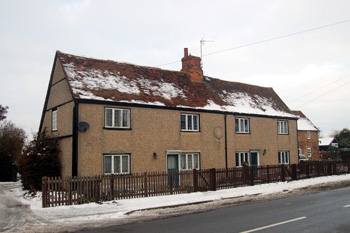
314 and 315 Cople Road - Christmas Eve 2010
314 and 315 Cople Road were listed by English Heritage in May 1984 as Grade II, of special interest. They dated the properties to the 18th century. They were restored by Samuel Whitbread in 1913. They are built of pebble-dashed roughcast over a timber frame with a clay tiled roof and have a modern lean-to extension at the rear.
We are fortunate that three surveys of the parish of Cardington from the late 18th century survive. The first of these was undertaken in 1782 by James Lilburne. He was the parish schoolmaster and later agent for Samuel Whitbread, who owned large estates in the parish and also the sole Enclosure Commissioner for the parish. He produced a list of all the inhabitants of the parish arranged by house and hamlet [P38/28/1]. This was published, with extensive analysis by County Archaeologist David Baker in 1973 as Bedfordshire Historical Record Society Volume 52.
Since publication a second list has been found [P38/28/2]. It carries revisions up to the year 1789. Sadly neither of these surveys includes a map. Finally, in 1794 Lilburne produced another survey [W2/6/1-3] and this one had a map with a key showing where each house was. One can use this to plot the houses of the previous surveys and this work was carried out by John Wood of Bedfordshire County Council’s Conservation Section in October 1982 [CRT130Cardington29].
The 1782 survey [P38/28/1/2] described the premises as a cottage divided into two tenements, lived in by Thomas Brown and John White. Thomas Brown was a 60 year old labourer who had been born in Cardington. His wife was 56 year old Mary, née Field, who had been born at Renhold. She spun linen and was a dissenter, that is, a nonconformist in religion. Both were willing to be inoculated against smallpox if others in the village were.
John White was a 59 year old carpenter who had been born in Cardington. His wife was 41 year old Elizabeth, née Chiles, who had been born in “Paveingham”, i.e. Pavenham. She made lace. Both were willing to be inoculated against smallpox if others in the village were. Their daughter was 13 year old Elizabeth who also made lace. She had learned to sing and was unwilling to be inoculated against smallpox. By 1787 she was in service at Elstow. She had never been to school. By 1787 George White, a carpenter who was 24 years old and had been born in Cardington was also living at the address, he was probably John and Elizabeth’s son. He married Frances Woodfield from Bedford on 9th January 1787. She made lace. Their son George was born on 16th November that year. Both families were still in residence in 1794 [W6/2/1-3].
The Rating and Valuation Act 1925 specified that every building and piece of land in the country was to be assessed to determine its rateable value. Cardington, like most of the county, was assessed in 1927 and the valuer visiting 314 and 315 Cople Road [DV1/C116/28-29] found them both owned by the Whitbread Estate.
Number 314 was occupied by A. Edwards who paid rent of £7/16/- per annum. His accommodation comprised a parlour, living room and passageway downstairs with two bedrooms above.
Next door was the shop of Wilfred A. Wilmot, who paid rent of £3/4/10 per annum. The shop, a living room and passageway comprised the ground floor with two bedrooms above. The valuer noted that the shop measured 12 feet by 14 feet and commented: “really living room”. A washhouse stood outside. Every few years in the early 20th century a new Kelly's Directory for Bedfordshire was published. Wilfred Wilmot is first listed in the edition of 1924 and last listed in 1936. The 1940 edition, the last Kelly's for the county gives the shopkeeper as Mrs. L. E. Wilmot